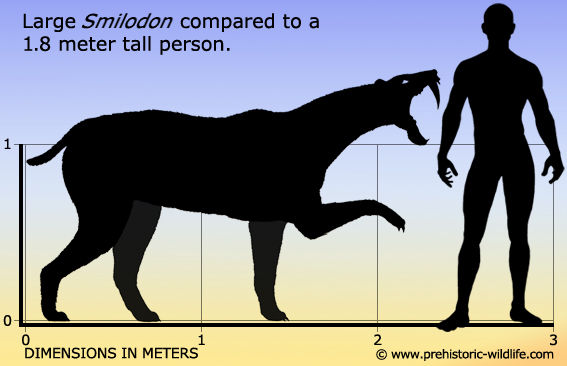
CREATURE-PEDIA
Smilodon




Smilodon also known as the Saber-toothed cat is perhaps one of the most famous prehistoric mammals. Although commonly known as the saber-toothed tiger, it was not closely related to the tiger or other modern cats. Smilodon lived in the Americas during the Pleistocene Period (2.5 million years ago to 10,000 years ago). Smilodon was around the size of modern big cats, but was more robustly built. It had a reduced lumbar region, high scapula, short tail, and broad limbs with relatively short feet. Smilodon is most famous for its relatively long canine teeth, which are the longest found in the saber-toothed cats, at about 28 cm (11 in) long in the largest species. The canines were slender and had fine serrations on the front and back side. It ranged from 350 to 620 lb, and reached a shoulder height of 100 cm (39 in) and body length of 175 cm (69 in). It was similar to a lion in dimensions, but was more robust and muscular, and therefore had a larger body mass. Scientists debate whether Smilodon was social. One study of African predators found that social predators like lions and spotted hyenas respond more to the distress calls of prey than solitary species. Since Smilodon fossils are common at the La Brea Tar Pits, and were likely attracted by the distress calls of stuck prey, this could mean that this species was social as well. The structure of the hyoid bones suggest that Smilodon communicated by roaring, like modern big cats. Smilodon lived during the Pleistocene epoch (2.5 mya–10,000 years ago), and was perhaps the most recent of the saber-toothed cats. Smilodon probably lived in a closed habitat such as forest or bush. Despite being more powerfully built than other large cats, Smilodon actually had a weaker bite. Modern big cats have more pronounced zygomatic arches, while Smilodon had smaller zygomatic arches which restricted the thickness and therefore power of the temporalis muscles, and thus reduced Smilodon’s bite force. Analysis of its narrow jaws indicates it could produce a bite only a third as strong as that of a lion. There seems to a be a general rule that the saber-toothed cats with the largest canines had proportionally weaker bites. However, analyses of canine bending strength (the ability of the canine teeth to resist bending forces without breaking) and bite forces indicate the saber-toothed cats' teeth were stronger relative to the bite force than those of modern "big cats". In addition, Smilodon could open its jaws 120 degrees, whereas the lion's gape is limited to 60 degrees. Smilodon were very successful predators and survived up until as recently as 10,000 years ago, but eventually the world around them changed too much. The climate became cooler and drier, the larger prey they specialized in killing disappeared, their world came to an end.
Fun Fact
Despite the name Saber-Toothed Tiger, Smilodon was not a Tiger, or related to a Tiger.
Did You Know?
Smilodon was about the size of a Lion and had short tail like a Bobcat.

